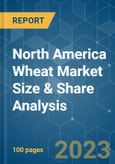Key Highlights
- Wheat is one of the key global commodities in terms of acreage and tradeable value and is a staple in household diets. Many factors affect wheat prices, including climate, yields, oil prices, lagged prices, and imports. In addition to gradually and consistently increasing global wheat demand, these market drivers are posited to impact world prices and food security. Approximately 21% of the world's food depends on annual wheat crop harvests, which often have relatively low stocks. The developing countries, mostly net wheat importers, consume 77% of total global wheat production.
- Wheat ranks third among United States' field crops in planted acreage, production, and gross farm receipts behind corn and soybeans. In the marketing year 2022, United States farmers produced 1.6 billion bushels of winter, durum, and other spring wheat from a harvested area of 35.5 million acres. Canada remains one of the world's top exporters of high-quality durum. Canada's wheat harvest is about 30 million metric tons on average, about 7 times what Canadians consume.
- Wheat Belt, the part of the North American Great Plains, is the major growing wheat region. The southern area, where hard red winter wheat is grown, includes parts of the states of Kansas, Oklahoma, Texas, Nebraska, and Colorado since this area is hot and dry in summer and is thus well suited to winter wheat. On average, winter wheat production represents approximately 70 percent of total U.S. production. Across the United States, there are six classes of wheat grown. The six classes grown in the United States are hard red winter, hard red spring, soft red winter, soft white, hard white, and durum.
- Growing demand for animal feed and biofuels in North America has led to an increase in wheat production. The massive increase in biofuel production is majorly driven by the very large government subsidies provided in many western countries, which have simultaneously increased the subsidization of biofuel. The federal government is providing subsidies to increase the consumption of biofuels such as wheat ethanol. Some biofuels are cost-competitive with traditional fuels and make a useful addition to gasoline.
North America Wheat Market Trends
Growing Demand for Biofuels and Animal Feed
- The United States produces mainly biodiesel and ethanol fuel, which uses wheat as the main feedstock. According to the United States Energy Information Administration (US EIA), the United States biodiesel production was 159 million gallons in December 2020. Biodiesel production in December 2020 was 8 million gallons higher than in November 2020. Biodiesel production from the Midwest region (Petroleum Administration for Defense District 2) accounted for 72 percent of the United States’ total. Production came from 85 biodiesel plants with a capacity of 2.5 billion gallons per year.
- Biodiesel can be produced locally in Canada and can provide local economies with a new market for their agricultural products and waste. In Canada, high-yielding wheat-based bioenergy crops are developed to reduce the dependence on petroleum for transportation and reduce greenhouse gas (GHG) emissions. Although wheat represents a part of the production of biofuels in Canada, only 2.9% of the total wheat harvested in Canada is used for bioethanol production, while corn is mainly used. However, the federal government is providing subsidies to increase the production of biofuels such as wheat ethanol, which is expected to drive the wheat market.
- According to the Alltech survey 2021, the United States is the second largest country in terms of animal feed, with 215.9 million metric tons of production volume in 2020. In 2021, the Decision Innovation Solutions (DIS) of the American Feed Industry Association (AFIA), pets and domestic livestock in the United States consumed approximately 284 million metric tons of animal food. The top three feed consumers included beef cattle at 64.5 million metric tons, hogs at 61.8 million tons, and broiler chickens at 60.8 million tons. Iowa, Texas, California, North Carolina, and Minnesota topped the list for the sheer amount of animal food consumed with 28.8 million metric tons, 21.1 million metric tons, 17.5 million metric tons, 16.3 million metric tons, and 14.6 million metric tons, respectively.
United States Dominates the Market
- Wheat is the principal food grain produced in the United States. The three primary varieties of grain domestically sown are winter wheat, spring wheat, and durum wheat. The country's consumer demand for food products made from wheat flour is relatively stable and largely unaffected by changes in wheat prices or disposable income. According to the United States Department of Agriculture (USDA), the United States wheat highlights included the National Agricultural Statistics Service (NASS) estimate of 34.4 million acres of winter wheat planted for harvest in 2022.
- Although the United States typically produces only about 6-7 percent of the world’s wheat, it is a major wheat exporter. However, the country's production was observed at 44,790,360 metric tons in 2021. USDA estimates that farmers have seeded 79% of the 2023 winter wheat crop. United States wheat farmers continue to produce sufficient high-quality wheat supplies to meet domestic and international needs for hundreds of unique baked goods.
- The country’s all-wheat feed and residual for 2022 was forecasted to be 30 million bushels lower at 50 million, which triggered the wheat imports to be raised by 10 million bushels at 120 million, up from 95 million in 2021. Kansas, Oklahoma, and Texas are the key producing areas of the Hard Red Winter (HRW) wheat variety which will expand planting areas to elevate the commodity prices.
North America Wheat Industry Overview
Additional Benefits:
- The market estimate (ME) sheet in Excel format
- 3 months of analyst support
Table of Contents
Methodology

LOADING...










